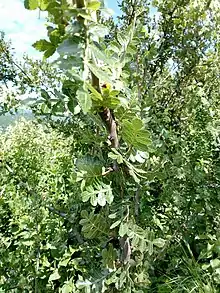| Bursera glabrifolia | |
|---|---|
 | |
| Scientific classification | |
| Kingdom: | Plantae |
| Clade: | Tracheophytes |
| Clade: | Angiosperms |
| Clade: | Eudicots |
| Clade: | Rosids |
| Order: | Sapindales |
| Family: | Burseraceae |
| Genus: | Bursera |
| Species: | B. glabrifolia |
| Binomial name | |
| Bursera glabrifolia | |
| Synonyms[1] | |
|
List
| |
Bursera glabrifolia is a species of tree native to central Mexico (Guerrero, Morelos, Michoacán, México State, Puebla, Oaxaca).[2]
Bursera glabrifolia is one of two species commonly referred to as copal. Copal is the wood most commonly used by the woodcarvers in Oaxaca, Mexico. The woodcarvers refer to Bursera glabrifolia as "macho" or male copal, which they like less than Bursera bipinnata, which they refer to as "Hembra" or female copal.[3]
Bursera glabrifolia is a small tree native to the tropical dry forests of Mexico. It was first described by Carl Sigismund Kunth in 1824 as Elaphrium glabrifolium and then transferred to the genus Bursera by Adolf Engler in 1896.[2]
References
- ↑ The Plant List, Bursera glabrifolia (Kunth) Engl.
- 1 2 McVaugh, R.; Rzedowski, J. (1965). "Synopsis of the Genus Bursera L. in Western Mexico, with Notes on the Material of Bursera Collected by Sessé & Mociño". Kew Bulletin. 18 (2): 317–382. doi:10.2307/4109252. JSTOR 4109252.
- ↑ Chibnik, Michael (2010) [2003]. Crafting Tradition: The Making and Marketing of Oaxacan Wood Carvings. University of Texas Press. ISBN 978-0-292-78266-2.
This article is issued from Wikipedia. The text is licensed under Creative Commons - Attribution - Sharealike. Additional terms may apply for the media files.